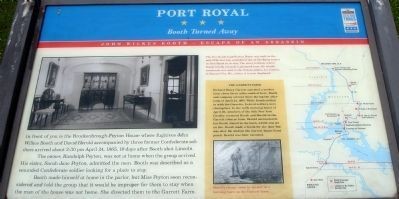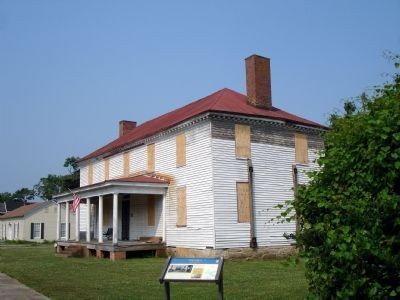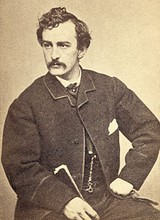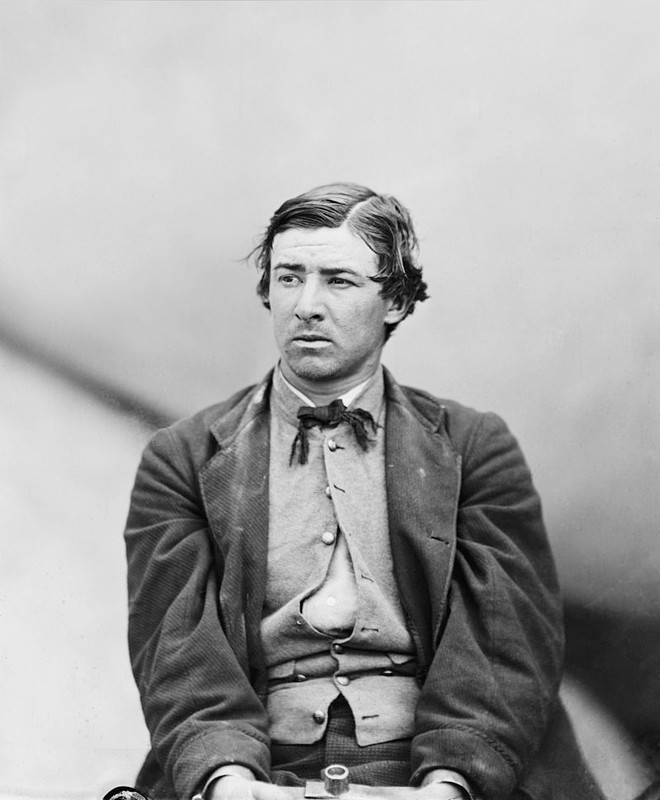Peyton House (Port Royal)
Introduction
Text-to-speech Audio
The Randolph Peyton House was the second-to-last place John Wilkes Booth was seen alive as he and others escaped following his assassination of President Lincoln. They entered Virginia expecting a hero's welcome but received little if any material support from the Confederate sympathizers he visited. From here Booth and co-conspirator David Herold were led to Garrett's farm where pursuing federal soldiers detained Herold and killed Booth.
Images
The Port Royal Civil War Trails marker outside the Peyton House. Booth arrived expecting southern hospitality, but it was good old-fashioned dignity that turned him away. The 'man of the house' was not home.

The "Brockenbrough-Peyton House" as of May, 2007. The once-celebrated mansion gained national notoriety as the second-to-last stop of Booth's escape from Union justice after he murdered President Lincoln.

Famous photo of John Wilkes Booth

David Herold, under arrest in the Washington Naval Yard, 1865

Backstory and Context
Text-to-speech Audio
John Wilkes Booth escaped into Virginia eight days after he shot Lincoln at Ford's Theatre. Believing himself a hero of the South for his action, Booth was surprised at the lack of welcome he received from Confederate sympathizers along the way. The further he fled, the less help he received as even those who may have shared his feelings about Lincoln feared having any connection to the former actor as United States soldiers closed in on Booth's trail and arrested all who were suspected of harboring the most wanted fugitive in American history to that time.
The Peyton House, also known as the Brockenbrough House and the Brokenbrough-Peyton House, was one of Port Royal, Virginia’s first and most famous 19th-century mansions. After owner Champe Brockenbrough’s widow died in 1849, the mansion was occupied by the Valentine Peyton family, and the house became known as the Peyton House.
Booth and Herold left Cleydael, the home of Dr. Stuart, with no more help than a begrudgingly-given warm dinner. Instead of the warm beds of Stuart’s gentlemanly estate, they were sent off to the nearby sharecropper’s shack belonging to William Lucas, a free Black man. Booth was a notorious hater of Blacks and so evicted the Lucas family so the fugitives could sleep in the house by themselves. The next morning, Booth hired Lucas’s son, Charley, to drive him to Port Conway on the Rappahannock River. While waiting for passage across the river, the fugitives met three Confederate soldiers—A.R. Bainbridge, Lt. Mortimer Bainbridge Ruggles, and William Jett. Herold could not protect the fugitives’ secret and proudly claimed "We are the assassinators of the President. Yonder is J. Wilkes Booth, the man who killed Lincoln." The two parties rode the ferry together to Port Royal.
On April 23, 1865, Willie Jett led the fugitives to the Peyton Randolph House. Desperate for welcome, the two Confederate conspirators were disappointed again. They were initially invited inside, believing Booth to be a wounded Confederate soldier. But Randolph Peyton was not home and his two sisters, Sarah and Lucy, balked at the men staying the night. They considered males guests without “the man of the house” present to be inappropriate and so Sarah suggested Jet take the men elsewhere. She first suggested the home of George Washington Catlett across the street but they were not home either. So Sarah suggested they find accommodations three miles down the road at the Garrett farm. Booth was once unceremoniously again sent away. He did not know it, but the Peyton House would be the last home Booth ever left alive.
Days later, on April 26, Union investigator Everton Conger of the 16th New York Cavalry learned of the five Confederates who crossed the Rappahannock together. They found Willie Jet at the Star Hotel in Bowling Green, dragged him out of bed, and demanded to know "Where are the two men who came with you across the river?" Jett told the soldiers what he knew, that they were on their way to Garrett’s farm.
Largely abandoned today, efforts are underway to restore the house.
Sources
Linder, Doug. "The Trial of the Lincoln Assassination Conspirators." Famous American Trials. 2007. Accessed August 11, 2016. http://law2.umkc.edu/faculty/projects/ftrials/lincolnconspiracy/lincolnaccount.html.
Mink, Eric J. "Brutus' Judas: Willie Jett." Mysteries and Conundrums. April 20, 2011. Accessed August 11, 2016. https://npsfrsp.wordpress.com/2011/04/20/brutus’-judas-willie-jett-part-1.
Swain, Craig, Ed. "Port Royal: Booth Turned Away." Historical Marker Database. June 16, 2016. Accessed August 11, 2016. http://www.hmdb.org/marker.asp?marker=4525&Result=1.
